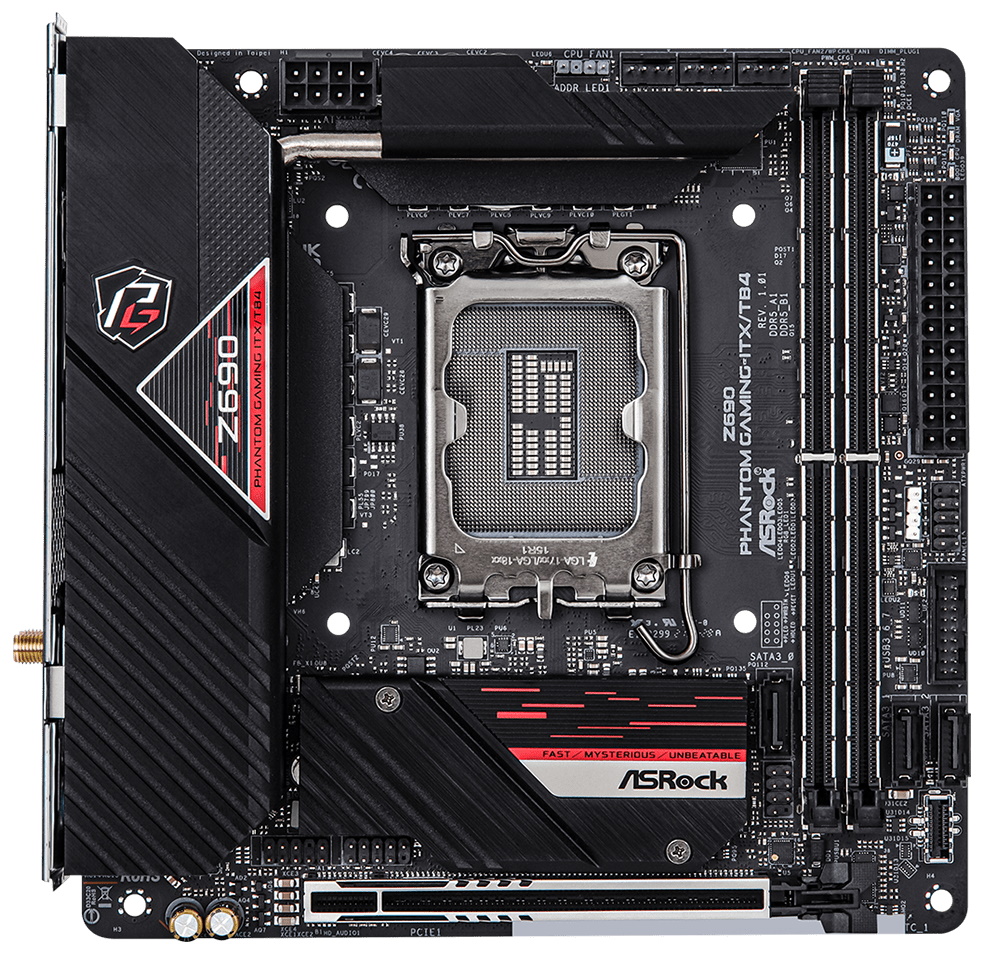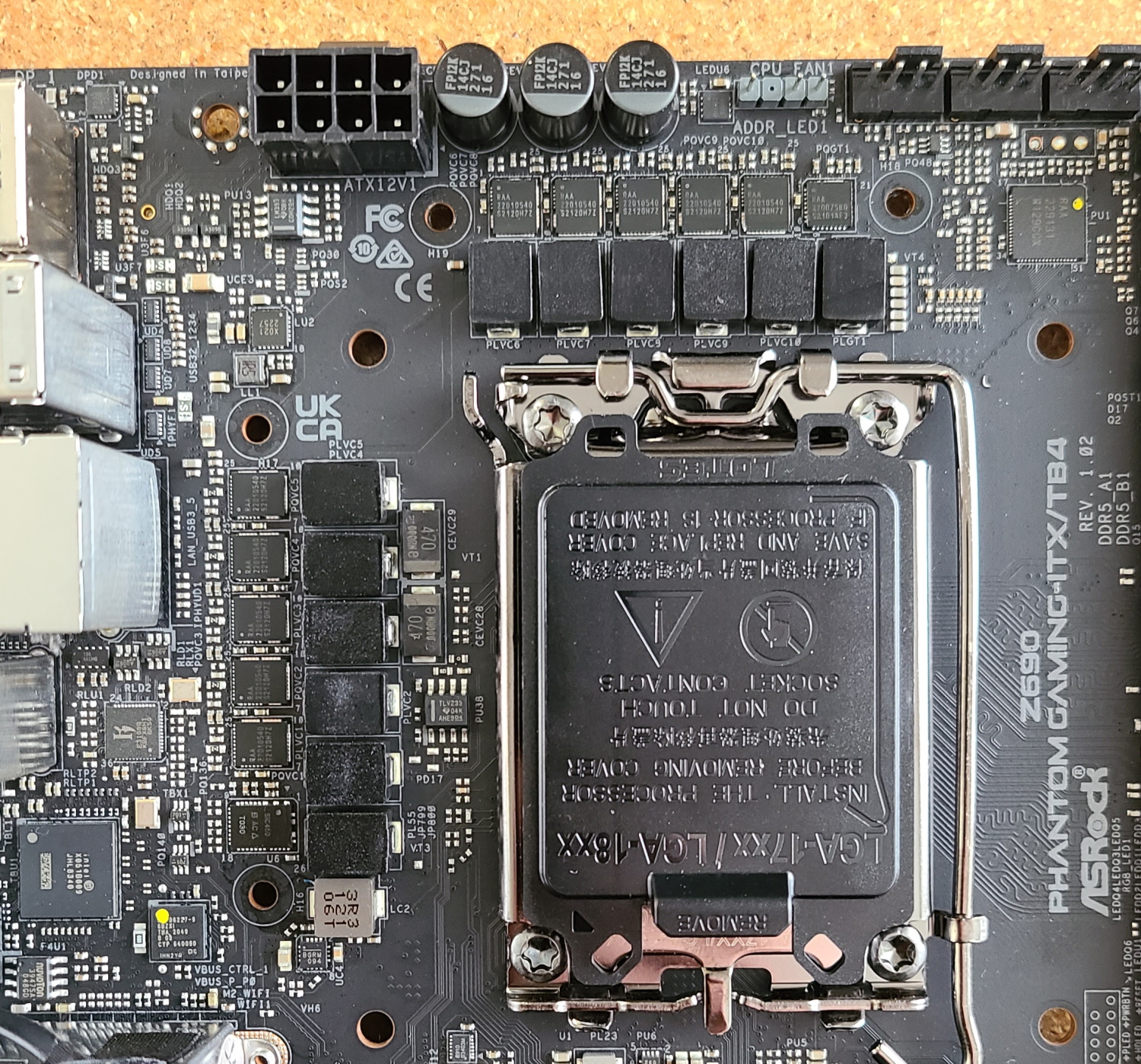Tom's Hardware Verdict
The ASRock Z690 PG-ITX/TB4 includes robust 105A power delivery, two M.2 sockets and integrated Thunderbolt 4 ports. If the five rear Type-A ports are enough, along with three SATA ports, many will find the lower $349.99 price point more palatable than its direct competition.
Pros
- +
+ Integrated Thunderbolt 4
- +
+ Robust 105A power delivery
Cons
- -
Five Type-A ports and three SATA ports
- -
Last-gen audio codec
Why you can trust Tom's Hardware
The ASRock Z690 Phantom Gaming-ITX/TB4 is a compact Mini-ITX board that’s priced below most other Z690-based ITX offerings, at $349.99. But don’t let the price fool you. This little board packs almost the same punch as the higher-priced MSI MEG Z690I Unify we reviewed recently. The PG-ITX/TB4 comes with capable 10-phase power delivery, Thunderbolt 4, two M.2 sockets, three SATA ports and a last-generation flagship audio codec. Is the lower price worth having less of some items but full Thunderbolt 4 support? That’s up to you to decide, but we’ll help you get there.
If we take a moment to compare the previous-gen Z590 PG-ITX/TB4, we don’t see too many hardware changes outside of supporting the latest Alder Lake processors, along with PCIe 5.0 and DDR5 RAM. M.2 socket count remained the same (two), and SATA port count (three). Killer-based networking, integrated Thunderbolt 4 and even the last-gen flagship audio codec are all carryovers from the previous ITX Phantom. ASRock did improve upon the power delivery and tweaked the appearance, though the former was more of a necessity than an option.
Performance on the ASRock Z690 ITX/TB4 was all over the place. Some results were good and faster much of the competition, while others were slower. We saw above-average results in the Office tests within UL’s Procyon Office benchmark and in gaming, but Cinebench and memory bandwidth testing, among others, were on the slower side of the Z690 spectrum. Memory bandwidth in particular can certainly affect other results, especially in memory-sensitive applications.
While not much has changed on this generation’s Phantom Gaming ITX/TB4, not much has to. It’s a Mini-ITX size board, so there are inevitably some limitations. Whether or not you can live with them, is up to each person and use case. But since you’re paying a premium to use a small form factor, be sure it can support your needs, as expansion is limited. We’ll dig into the details shortly, but before we do, here are the full list of specifications from ASRock.
ASRock Z690 Phantom Gaming-ITX/TB4 Specifications
| Socket | LGA1700 |
| Chipset | Z690 |
| Form Factor | ITX |
| Voltage Regulator | 11 Phase (10+1, 105A SPS MOSFETs for Vcore) |
| Video Ports | (1) HDMI (v2.1) |
| Row 5 - Cell 0 | (1) DisplayPort (v1.4) |
| Row 6 - Cell 0 | (1) Thunderbolt 4 (Type-C) |
| USB Ports | (1) Thunderbolt 4 (Type-C) (40/20/10 Gbps) |
| Row 8 - Cell 0 | (4) USB 3.2 Gen 2 Type-C (10 Gbps) |
| Row 9 - Cell 0 | (1) USB 3.2 Gen 1 (5 Gbps) |
| Network Jacks | (1) 2.5 GbE |
| Audio Jacks | (5) Analog + SDPIF |
| Legacy Ports/Jacks | ✗ |
| Other Ports/Jack | ✗ |
| PCIe x16 | (1) v5.0 (x16) |
| PCIe x8 | ✗ |
| PCIe x4 | ✗ |
| PCIe x1 | ✗ |
| CrossFire/SLI | ✗ |
| DIMM slots | (2) DDR5 6400+(OC), 64GB Capacity |
| M.2 slots | (1) PCIe 4.0 x4 (64 Gbps) / PCIe (up to 80mm) |
| Row 21 - Cell 0 | (1) PCIe 4.0 x4 (64 Gbps) / PCIe + SATA (up to 80mm) |
| U.2 Ports | ✗ |
| SATA Ports | (3) SATA3 6 Gbps (Supports RAID 0/1/5/10) |
| USB Headers | (1) USB v3.2 Gen 2x2, Type-C (20 Gbps) |
| Row 25 - Cell 0 | (1) USB v3.2 Gen 1 (5 Gbps) |
| Row 26 - Cell 0 | (1) USB v2.0 (480 Mbps) |
| Fan/Pump Headers | (3) 4-Pin (CPU, Water pump, Chassis) |
| RGB Headers | (1) aRGB (3-pin) |
| Row 29 - Cell 0 | (1) RGB (4-pin) |
| Diagnostics Panel | Post Status Checker |
| Internal Button/Switch | ✗ |
| SATA Controllers | ✗ |
| Ethernet Controller(s) | (1) Killer E3100G (2.5 Gbps) |
| Wi-Fi / Bluetooth | Killer AX1675 Wi-Fi 6E (2x2 ax, MU-MIMO, 2.4/5/6 GHz, 160 MHz, BT 5.2) |
| USB Controllers | ✗ |
| HD Audio Codec | Realtek ALC1220 |
| DDL/DTS Connect | ✗ / X |
| Warranty | 3 Years |
Inside the Box of the ASRock Z690 Phantom Gaming-ITX/TB4
While the accessory stack below the box’s cardboard partition doesn’t include much, it should have what you need to get started without a trip to the store.
- Quick Installation Guide
- Software Setup Guide
- Wi-Fi Antenna
- DVD driver disk
- PG keycap
- Case badge
- (2) SATA Data Cables
- (2) M.2 screws
Design of the ASRock Z690 Phantom Gaming-ITX/TB4



Since this is a Mini-ITX motherboard, we’ll start the board tour with the left side and work our way around clockwise. One of the first things I see is the large VRM heatsink that covers a portion of the 10-layer PCB and keeps the VRMs underneath cool, with the help of a tiny fan hiding below. The large black heatsink sports the Phantom gaming branding, with its black and red theme and the name of the board on top as the only color contrast. A heatpipe connects this part to the tall top VRM heatsink. Overall, the appearance won’t win any awards, but it certainly won’t detract from most build themes.
Hidden below towards the bottom of the board are the Realtek ALC1220 codec and a couple of Nichicon Gold audio capacitors. While this audio solution will undoubtedly be fine for most users, I would like to see the latest audio codec used since other Z690 Mini-ITX options, including the less–expensive model, all have newer audio options.
Get Tom's Hardware's best news and in-depth reviews, straight to your inbox.
Along the top, we spy an 8-pin EPS connector to power the CPU. Above the top VRM heatsink, we run into a 3-pin ARGB header. Since the board doesn’t include any LEDs, this is the only way to add RGB bling to your system. You can control these attached elements through ASRock’s Polychrome Sync software.
Next, we run into three 4-pin fan headers. CPU_Fan1/2 supports up to 1A/12W output, while the CPU/Water Pump header supports up to 2A/24W. CPU_FAN2/WP can also auto-detect if a 3-pin or 4-pin fan is in use. Otherwise, you’ll have to configure the header in the BIOS manually.
ASRock upgraded the power delivery compared to Z590 and added more phases and better MOSFETs. Power comes from the 8-pin EPS connector and onto a RAA229131 20-channel controller and ends at the 10 105A Renesas RAA22010540 SPS MOSFETs dedicated to Vcore. The 1,050A available is plenty to power your flagship Intel Core i9-12900K processor at stock and overclocked.
Along the right side of the board are two reinforced DRAM slots. ASRock lists capacity up to 64GB and supports up to DDR5 6400+(OC) speeds. The speed specification is lower than the MSI Z690I Unify, but most aren’t trying to break overclocking records in with a board like this. And this value is well past the DDR5 sweet spot for price and performance.
Next, we run into the four Debug LEDs on the right edge, which helps troubleshoot POST issues. Next is a 24-pin ATX connector to power the board and a 4-pin RGB header. Next to that is the front panel header, a USB 3.2 Gen 1 (10 Gbps) header and a USB 3.2 Gen 2x2 (20 Gbps) header. Mixed in between are three SATA ports that support RAID0/1/5/10 modes. ASRock doesn’t mention any sharing of the SATA ports, so you should be able to run any NVMe- and SATA-based M.2 modules and three SATA drives at the same time.
Across the bottom, you’ll find the single PCIe 5.0 x16 slot for graphics. Like the M.2 sockets and SATA ports, you don’t lose any lanes here either. Above the PCIe slot is a USB 2.0 header and front panel audio. And above that is the primary M.2 socket, labeled M2_1, on the front, while behind it on the back of the motherboard is the second M.2 socket. Both sockets support PCIe 4.0 x4 (64 Gbps) bandwidth and 80mm drives. M2_2 on the back supports SATA and PCIe-based devices. If you want to increase the speed or run M.2 drives in parity, the PG ITX/TB4 supports RAID0/1/5 modes on NVMe drives.
ASRock, like most boards in this price range, uses a pre-installed IO plate that matches the black and red theme of the Phantom Gaming ITX/TB4. White writing is used to label the ports, making them easy to identify. Outside of that, there are a bunch of hexagonal-shaped holes in the rear IO plate to allow the VRM fan to breathe.
Starting on the left, there’s a DisplayPort and HDMI port for video and the Thunderbolt header for those who want to connect monitors that way. There are five USB Type-A ports here, with four USB 3.2 Gen 2 (10 Gbps) ports and one USB 3.2 Gen 1 (5 Gbps) port. This will not be enough ports for some, so be sure to keep that in mind. The Killer 2.5 GbE network ports sit above the Thunderbolt 4 port, while the Killer Wi-Fi antenna connections are to the right. In the middle are BIOS Flashback and Clear CMOS buttons. Last but not least, the ITX/TB4 sports a full 5-plug plus SPDIF audio stack.
MORE: Best Motherboards
MORE: How To Choose A Motherboard
MORE: All Motherboard Content

Joe Shields is a staff writer at Tom’s Hardware. He reviews motherboards and PC components.
-
tennis2 $350...insaneReply
Can I suggest placing the "best" metric at the top of the charts. Whether that's "lower is better" or "higher is better". -
Co BIY ITX could have an appeal to me ... if it didn't always cost more.Reply
Even priced the same as mATX would make sense but priced higher it looses appeal for me.
Complaining about fewer SATA ports on an ITX board seems silly.
If one needed (max) for transfer of data only. -
tennis2 @ AsRock, please give us mITX boards with 4 SODIMM slots. If you use a fixed peg in the middle, 2 SODIMMs will fit in the same slot length as a desktop stickReply -
ocer9999 Asrock does solid ITX motherboards, this Z690 Phantom is a good example. The pricing is on the high side, but all Z690 are. I see B660 selling for close to 200$ which is pretty crazy, so this price for a good ITX Z690 is not out of this world.Reply

